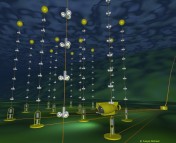Title: Searching for Dark Matter with Paleo-Detectors
Authors: S. Baum, A. K. Drukier, K. Freese, M. Górski, & P. Stengel
First Author’s Institution: The Oskar Klein Centre for Cosmoparticle Physics, Department of Physics, Stockholm University, Sweden
Status: Pre-print available [open access on arXiv]
Dark matter is, by its very nature, elusive. Though we can detect its presence by observing its gravitational influence, dark matter remains invisible because it doesn’t interact electromagnetically. The most widely accepted explanation for dark matter is the existence of weakly interacting massive particles (WIMPs). WIMPs, if eventually observed, would constitute a new, massive kind of elementary particle. Their discovery would be revolutionary for particle physics and cosmology; therefore, countless direct (in labs) and indirect (observing their annihilation or decay) detection experiments are being conducted to identify them. Today’s astrobite discusses a novel proposal for direct dark matter detection that seems more fit for scientists in Jurassic Park than for particle physicists: the paleo-detector.
The authors of today’s featured paper theorize that ancient rocks could contain evidence of interactions between WIMPS and nuclei in the minerals, forming a completely natural “detector” that would allow scientists to search for evidence of the massive particles using excavated rocks. This experiment varies significantly from other direct detection efforts, as those look for evidence of WIMPs hitting Earth-based detectors in real time. The paleo-detector would instead trace nanometers-long “tracks” of chemical and physical change in the rocks as the result of WIMP-induced nuclear recoil that occurred long ago.
In this framework, minerals are extracted from boreholes used for oil drilling and geological research. Probing those extreme depths is advantageous because the extracted rocks would be very well shielded from contaminating radiation, such as cosmic rays. The boreholes invoked in the paleo-detector proposal extend an impressive 12 km into rock — about five times deeper than the deepest functional laboratory in the world.
Of course, not all rocks are created equal (for this experiment, at least). The scientists include an analysis of four different mineral varieties: Zabuyelite, Halite (rock salt; see featured image), Iltisite, and Sylvanite (silver-gold telluride), all of which can be collected via deep boreholes. They are all relatively low-density, which ensures that WIMP interactions form longer tracks, and the quirks of their chemical composition allow perfect preservation of the tracks over longer-than-normal timespans. Additionally, the four minerals represent a wide range of nucleus weights. This diversity in turn causes identifiable variance within the lengths of the tracks scored into the rock by the recoil.
To search for these tracks, Baum et al. weigh the effectiveness of two distinct scanning mechanisms: electron microscopy (EM) and X-ray microscopy (XRM). EM allows for better (1 nm) resolution, but requires the samples to be broken open and prepared for scanning. XRM, on the other hand, yields a slightly worse track length resolution (5-15 nm), but does not necessitate any lengthy preparation of the samples. Figure 1 shows a comparison of sensitivity limits achieved using EM and XRM readings for the four different minerals in question.

Figure 1: Sensitivity to WIMP-nucleon interactions for each of the four minerals in question as a function of WIMP mass, which is currently unknown. (The lower the line, the higher the sensitivity to a given WIMP mass.) The left panel assumes samples were examined with EM, while the right panel shows results for soft XRM. The grey region represents the current sensitivity limits set by other direct detection experiments. Figure 2 in the paper.
As demonstrated in Figure 1, the authors found that the proposed paleo-detector is more sensitive than current limits by 2-3 orders of magnitude over a very wide range of possible WIMP masses. The paleo-detector is uniquely positioned among other direct detection experiments because the exposure time spans the length of Earth’s history, rather than the duration of a short-lived laboratory experiment. This longer exposure time has another possible advantage: since it is relatively easy to determine the age of these mineral samples, it would be possible to study changes in dark matter distribution in the galaxy as a function of time.
While the concept of using ancient relics to pursue cutting edge astrophysical research isn’t a new one, the paleo-detector is a testament to the boundless creativity that will be critical in tackling a problem as elusive as dark matter. Either by validating or by ruling out proposed solutions to the dark matter question, both indirect and direct detection methods are required to paint a complete picture of the invisible mass that surrounds us. Perhaps the dark matter scientists of the future will play the role not only of astrophysicist, but also of geologist. After all, astrophysical research, uh, finds a way.
(Featured image of Halite available with a creative commons license via Wikipedia)





Trackbacks/Pingbacks